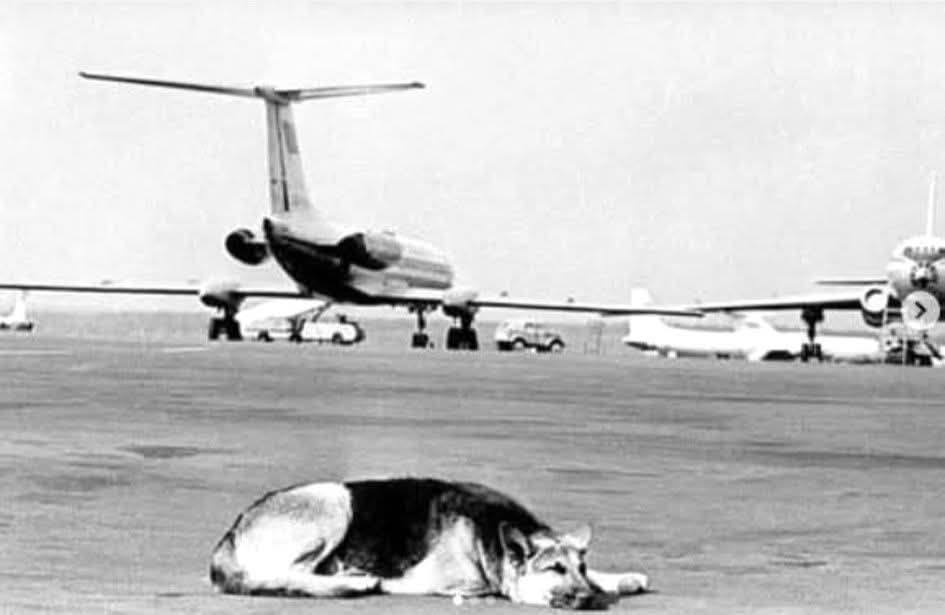The Dog Who Waited at the Runway


The Dog Who Waited at the Runway
In a time of fleeting commitments and forgettable promises, there once was a dog who chose faithfulness over comfort, and love over logic. Her name was Palma.
Chapter 1: The Last Goodbye
It was a quiet morning in the mid-1970s when a man and his German Shepherd arrived at Moscow’s Vnukovo International Airport. Palma, a healthy and bright-eyed dog, stayed close by her owner’s side. She likely didn’t know that this visit would mark the most painful moment of her life—the last time she would see him.
The man leaned down, wrapped his arms around her in a brief hug, and then unclipped her leash. Palma looked up, tail perhaps still wagging, expecting more affection or an invitation to follow. But her owner turned and walked away.
He didn’t look back.
As the engines of the Ilyushin Il-18 aircraft thundered to life and the wheels began to roll, Palma realized something was wrong. Her world—built around a single human—was crumbling. In a moment of panic and devotion, she sprinted across the runway, chasing the sound of the jet, chasing the last familiar scent, chasing what had always been hers: her human.
But the plane lifted off.
Palma was left behind on the tarmac, just a small figure watching a silver dot disappear into the clouds.
Chapter 2: The Long Wait
She didn’t leave.
Palma waited near the runway that day. And the next. And the next after that. She had no concept of time, ticketing policies, or flight schedules. What she knew—what her heart screamed—was that love meant waiting, even in the face of abandonment.
She found temporary shelter under a cargo trailer, dodging rain and snow. The airport workers began to recognize her. Some offered scraps of food. Others made her a makeshift shelter using tarps and wood. She was never aggressive. Never a threat. Just always there—watching.
Every time a plane landed, Palma rushed to meet it. Her nose twitched with hope. She scanned the passengers, tail cautiously wagging, eyes darting from face to face. But her human never stepped down.
She repeated this ritual for days. Then weeks. Then months.
Captain Viacheslav Valentei, a pilot who frequently operated flights in and out of Vnukovo, began noticing her from the cockpit. Always at her post. Always expectant. Palma became a fixture of the airfield, almost like a ghost of loyalty haunting the runway.

Chapter 3: The Story That Touched a Nation
In 1976, Palma’s silent vigil caught the attention of a reporter from the Soviet newspaper Komsomolskaya Pravda. The story, headlined simply but powerfully, told of a dog who had waited over a year at an airport for her owner to return.
The article struck a deep chord with readers across the USSR. In a society facing strict controls, political unrest, and an ongoing struggle for identity and meaning, Palma became a symbol. She was everything humans aspired to be: faithful, patient, hopeful.
Then came the unexpected twist.
A letter arrived at the newspaper office. It was from a man living in Norilsk, a remote city in Siberia. He claimed to be Palma’s former owner. According to his account, he had been unable to take Palma on the flight due to an eye condition that prevented her from flying. There were regulations. There was confusion. But there was no excuse.
He confirmed her identity.
But he never came back for her.
Chapter 4: The Dog with the Golden Heart
With national attention on Palma’s plight, adoption offers flooded in. Families from across the Soviet Union wanted to give her a home, to reward her unwavering love with warmth and comfort.
Eventually, Palma was adopted by Vera Kotliarevskaya, a schoolteacher from Kyiv. She traveled to Moscow and brought Palma home. By this time, the dog had aged. Her body was leaner, her movements slower. But her eyes still held the same watchfulness—the same question.
Would someone come back for her?
When Vera brought Palma to her house, something incredible happened. The dog approached Vera’s young daughter, sniffed her gently, then licked her cheek and softly nibbled her ear. It was as if Palma had found someone else to love. Someone new to protect. A new reason to stay.
Vera would later write in her diary:
“A very well-balanced dog, with a stable nervous system and a deep attachment to humans and home.”
Palma had found peace.
Chapter 5: Beyond the Runway
Palma’s story didn’t fade away. It was retold in homes, classrooms, and cafés across the country. In 1988, her tale became the inspiration for a Soviet film titled Tied to the Runway (Na Privyazi u Vzletnoy Polosy), directed by Vladimir Khmelnitsky. The film fictionalized elements of her life but kept the core message intact: a tribute to loyalty that defies reason.
The film added even more poignancy to her legend, cementing her status as one of the most beloved animals in Soviet cultural memory.
Palma’s story is often compared to that of Hachiko, the loyal Akita dog in Japan who waited for his deceased owner at Shibuya Station every day for nine years. But Palma’s story stands apart—not because of the length of her wait, but because she waited even after being rejected. She wasn’t waiting for a human who had died, but for one who chose not to come back.
And she forgave him.
Chapter 6: The Lessons We Forgot
Palma didn’t understand airlines. She didn’t know why she had been left behind, or why the man who once fed and loved her no longer appeared. What she did understand—what she lived—was loyalty in its purest form.
She reminds us of something deeply human yet often neglected:
That love, when real, doesn’t ask for justification.
That hope doesn’t expire.
That faith, even when painful, can become a quiet revolution.
In Palma’s eyes, every descending aircraft was a chance. Every stranger stepping down the stairs was a possibility. She turned heartbreak into duty and made waiting into a sacred act.
Chapter 7: Palma’s Legacy
Today, there is no bronze statue at Vnukovo Airport to honor Palma. Her story isn’t taught in schools across Europe or Asia. Yet in the hearts of those who’ve heard of her, she lives on.
In 2021, her tale inspired another film—A Dog Named Palma, a Russian family drama that revived public interest in her story for a new generation. Viewers were reminded once more of her astonishing emotional intelligence, her pain, and ultimately, her capacity to love.
Across cultures and decades, Palma’s story has found a place beside other loyal dogs in history. But unlike those who waited in the same spot for years, Palma adapted, found shelter, and even learned to love again.
Not every story of abandonment ends in bitterness. Some, like Palma’s, end in rebirth.
Final Words: The Soul of a Dog
Palma didn’t wear a uniform. She wasn’t trained for service or glory. She wasn’t bred for the spotlight. She was just a dog—forgotten by one human, cherished by many others.
But her actions spoke louder than most declarations of love could.
Palma represents something sacred: the quiet kind of devotion that asks for nothing in return. The love that keeps the light on even when it fears no one is coming back. The courage to forgive, the strength to wait, and the grace to move forward.
In the end, Palma may not have understood why she had to wait. But she waited anyway.
And in that choice, she became more than just a dog.
She became a symbol of what love really means.











